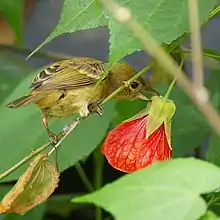| Diglossa | |
|---|---|
 | |
| Glossy flowerpiercer (D. lafresnayii) | |
| Scientific classification | |
| Domain: | Eukaryota |
| Kingdom: | Animalia |
| Phylum: | Chordata |
| Class: | Aves |
| Order: | Passeriformes |
| Family: | Thraupidae |
| Genus: | Diglossa Wagler, 1832 |
| Type species | |
| Diglossa baritula Wagler, 1832 | |
| Species | |
|
See text | |
Diglossa is a genus in the family Thraupidae. They are commonly known as flowerpiercers because of their habit of piercing the base of flowers to access nectar that otherwise would be out of reach. This is done with their highly modified bill, which is typically upswept, with a hook at the tip. Most members of the genus Diglossa are found in highlands of South America (especially the Andes), but two species are found in Central America.

Taxonomy and species list
The genus Diglossa was introduced by the German naturalist Johann Georg Wagler in 1832 with the cinnamon-bellied flowerpiercer (Diglossa baritula) as the type species.[1][2] The genus name is from the Ancient Greek diglōssos meaning "double-tongued" or "speaking two languages".[3] The genus now includes 18 species.[4]
- Golden-eyed flowerpiercer, Diglossa glauca
- Bluish flowerpiercer, Diglossa caerulescens
- Masked flowerpiercer, Diglossa cyanea
- Indigo flowerpiercer, Diglossa indigotica
- Rusty flowerpiercer, Diglossa sittoides
- Slaty flowerpiercer, Diglossa plumbea
- Cinnamon-bellied flowerpiercer, Diglossa baritula
- Moustached flowerpiercer, Diglossa mystacalis
- Glossy flowerpiercer, Diglossa lafresnayii
- Chestnut-bellied flowerpiercer, Diglossa gloriosissima
- Scaled flowerpiercer, Diglossa duidae
- Greater flowerpiercer, Diglossa major
- Venezuelan flowerpiercer, Diglossa venezuelensis
- White-sided flowerpiercer, Diglossa albilatera
- Grey-bellied flowerpiercer, Diglossa carbonaria
- Black-throated flowerpiercer, Diglossa brunneiventris
- Mérida flowerpiercer, Diglossa gloriosa
- Black flowerpiercer, Diglossa humeralis
References
- ↑ Wagler, Johann Georg (1832). "Mittheilungen über einige merkwürdige Thiere". Isis von Oken (in German). cols 275–282 [280–281].
- ↑ Paynter, Raymond A. Jr, ed. (1970). Check-List of Birds of the World. Vol. 13. Cambridge, Massachusetts: Museum of Comparative Zoology. p. 399.
- ↑ Jobling, James A. (2010). The Helm Dictionary of Scientific Bird Names. London: Christopher Helm. p. 136. ISBN 978-1-4081-2501-4.
- ↑ Gill, Frank; Donsker, David; Rasmussen, Pamela, eds. (July 2020). "Tanagers and allies". IOC World Bird List Version 10.2. International Ornithologists' Union. Retrieved 16 October 2020.
Further reading
- Mauck, William M. III; Burns, Kevin J. (2009). "Phylogeny, biogeography, and recurrent evolution of divergent bill types in the nectar-stealing flowerpiercers (Thraupini: Diglossa and Diglossopis)". Biological Journal of the Linnean Society. 98 (1): 14–28. doi:10.1111/j.1095-8312.2009.01278.x.
- Ridgely, R. S., & Tudor, G. (1989). Birds of South America. Vol. 1. Oxford University Press, Oxford. ISBN 0-19-857217-4